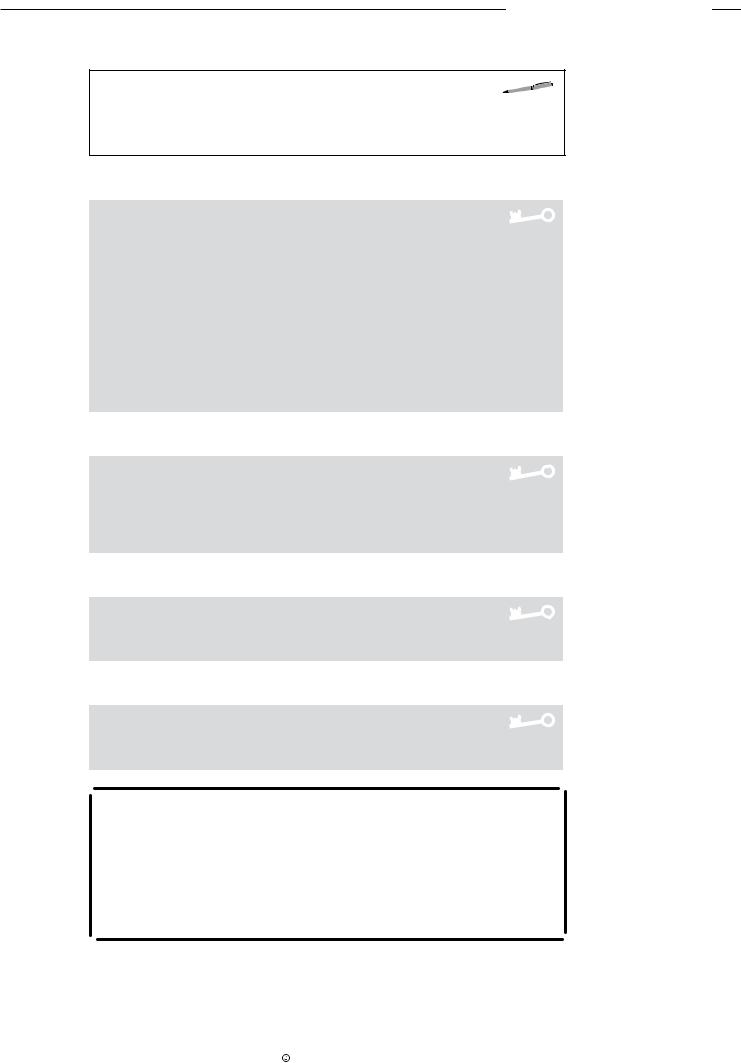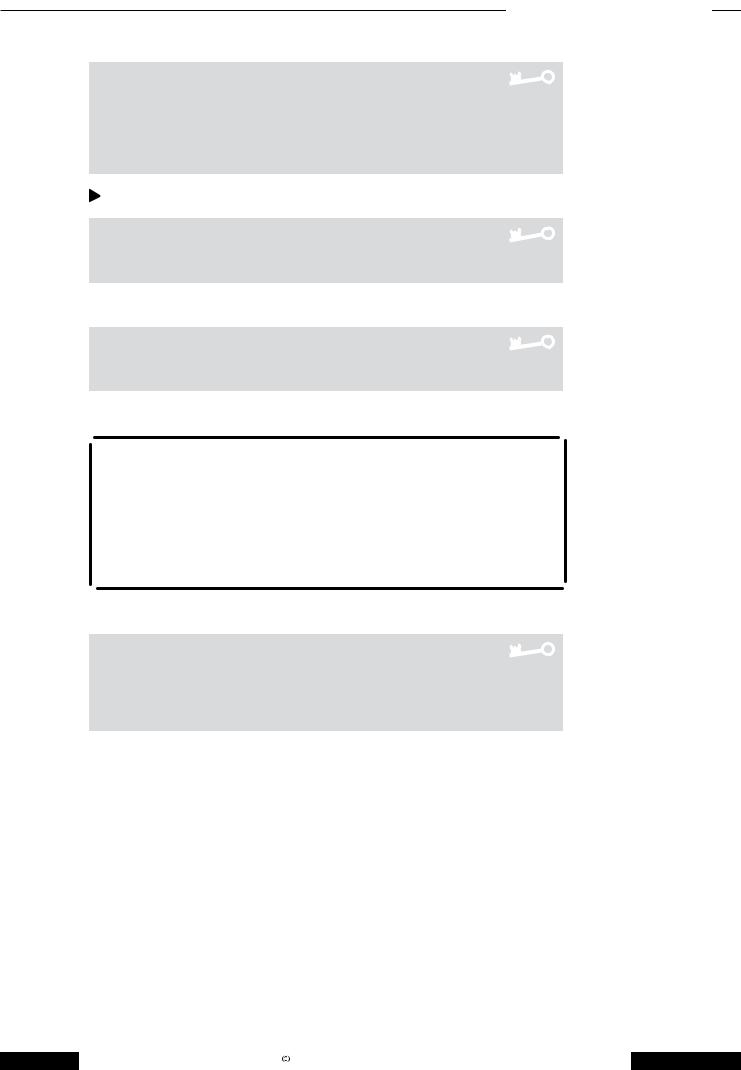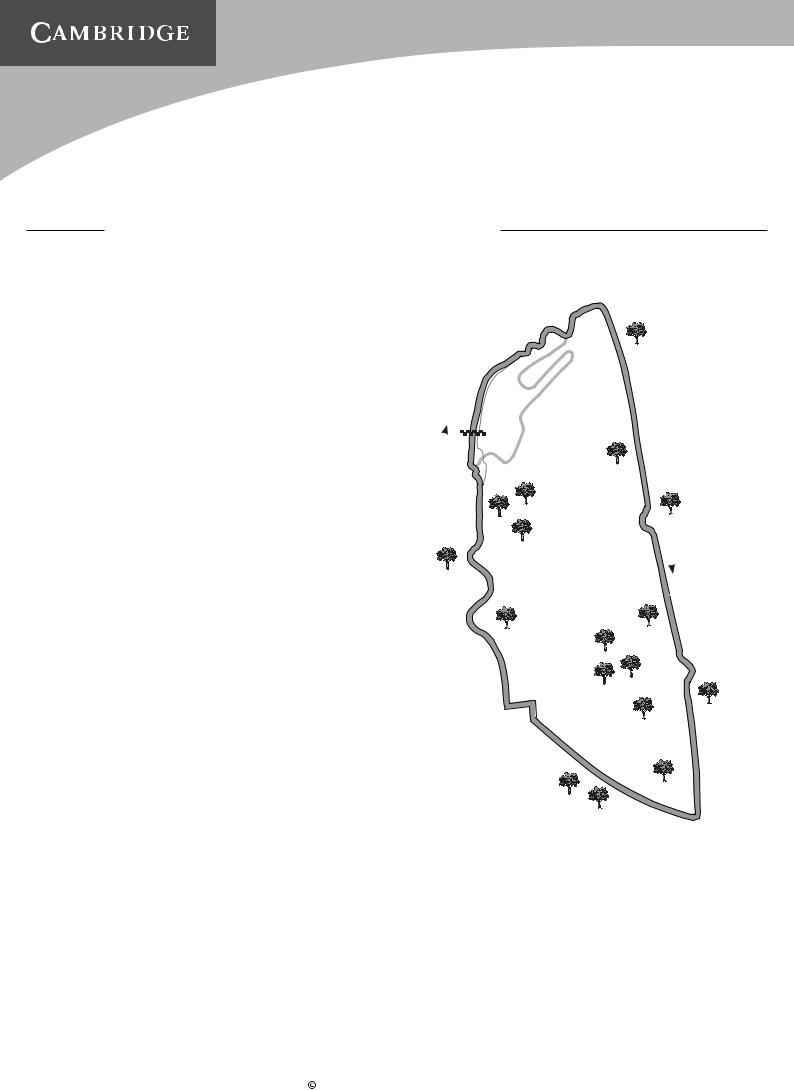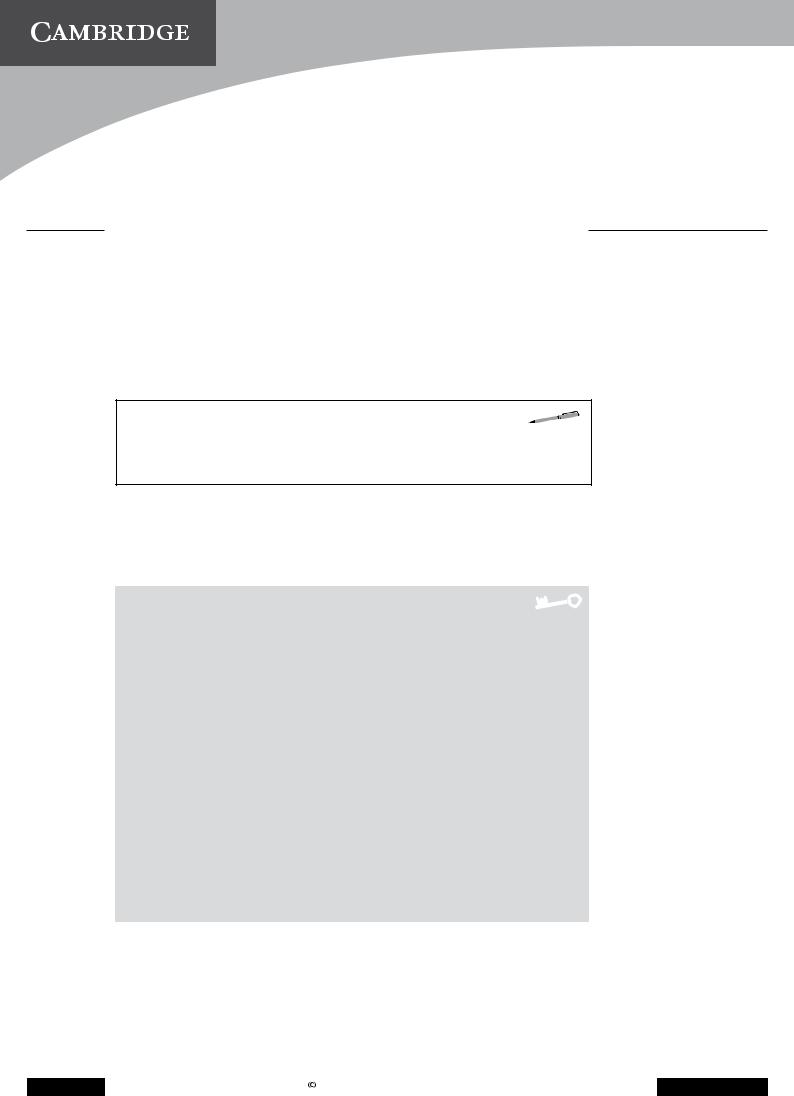
Keys Cambridge English for Engineering Teachers Notes
.pdf
UNIT 5 Breaking point Teacher’s Notes
Extension activity: more vocabulary
You could look at the meaning of some of the terms in Exercise 6a in more detail. warning message = an electronic display which describes a problem by displaying a text message
fuel injection system = a device in an internal combustion engine (a petrol/ gasoline or diesel engine) which injects vaporised fuel = an explosive mixture of fuel and air into the piston cylinder where it subsequently explodes, driving the piston downwards
sensor = a detecting/measuring device, for example a heat sensor or a pressure sensor
misfiring = when an engine is not running smoothly due to a fuel or ignition problem
refuel = fill up with fuel
tank = a tank is a static container for storing liquid outdoors or indoors or is part of a vehicle
tanker = a vehicle with a large tank on it which is used for transporting liquids in bulk
fuel pre-heater = a device in a diesel engine which heats up the fuel to be injected into the piston cylinder as the engine is started, allowing the vaporised fuel to explode more readily in the piston cylinder thus allowing the engine to start more quickly ‘it’s just one of the pre-heater plugs that’s gone’
gone = a general term to describe components that have failed ‘at the next service’
service = planned maintenance
Before you begin …
Give students Resource sheet 5b. Students match the words and definitions.
Answers
1 c 2 g 3 h 4 a 5 i 6 d 7 f 8 e 9 b
c Students complete the task in pairs.
Answers
1 b 2 c 3 a
d Students complete the task in pairs.
Suggested answers
1This is an intermittent problem. It’s probably caused by wear and tear.
2This was a sudden problem. It’s probably a faulty part, or an installation problem.
3This is a systematic problem. It’s probably a faulty part, or an installation problem.
e Students complete the table.
Answers |
|
|
|
2 |
It sounds like it’s |
4 |
I doubt it’s |
3 |
It could be / It might be |
5 |
It can’t be |
61 |
Cambridge English for Engineering |
Cambridge University Press 2008 |
Photocopiable |
|
www.cambridge.org/elt/englishforengineering |
||||
|
|
|||

UNIT 5 Breaking point Teacher’s Notes
f  5.3 Students complete the extracts and listen again to check their answers.
5.3 Students complete the extracts and listen again to check their answers.
Answers |
|
|
|
2 |
it might be |
5 |
I doubt it’s |
3 |
it might be |
6 |
It sounds like it’s |
4 |
it can’t be |
|
|
|
|
|
|
Before you begin …
Look at the meaning of the following terms.
dump truck = a large off-road truck used for carrying heavy loads of earth, rocks or minerals
quarry = a large hole in the ground (an opencast mine) from which minerals are dug down on power = has less power than it normally should
fuel consumption = the rate at which fuel is used
7 a Students complete the task in pairs.
Answers
minor; systematic
b Students complete the task in pairs.
Suggested answers
It can’t be water in the fuel supply. (This would cause misfiring.)
It could be a clogged fuel filter. (The engine is performing consistently, but is down on power.)
I doubt it’s a compression leak. (This would probably result in increased fuel consumption, and would probably cause more major problems.)
It can’t be a lubrication problem. (This would cause overheating.)
I doubt it’s a blockage in the exhaust system. (This would cause more major problems.)
 Describing the causes of faults
Describing the causes of faults
Language note
You will find the following vocabulary useful in this section.
abnormal, disproportionate, imbalance, inadequate, incorrect, inoperable, insufficient, irregular, malfunction, undersized/oversized, undetected
8 Students complete the task in pairs.
Answers
checklists = lists of things to be checked
standard procedures = specific, planned ways of dealing with situations and problems
back-up installations = secondary/additional equipment that will work if main equipment fails
planned maintenance = replacing parts at planned times even if they are not worn out
Before you begin …
Look at the meaning of the following terms.
hydraulic pipe = high-pressure oil pipe, used to push pistons called hydraulic rams fuel line = fuel pipe/hose
ruptured = broken/cracked gliding = flying without power
62 |
Cambridge English for Engineering |
Cambridge University Press 2008 |
Photocopiable |
|
www.cambridge.org/elt/englishforengineering |
||||
|
|
|||

UNIT 5 Breaking point Teacher’s Notes
9 a Students read the article and answer the questions. What could a pilot do in such a situation? Is it possible to control a large passenger aircraft when all engine power has been lost?
Answers
1An incorrect (oversized) hydraulic pipe was fitted to the right-hand engine.
2The pipe rubbed against a fuel line.
3The fuel line ruptured, resulting in a major leak.
b Students complete the task.
Answers |
|
|
|
04:58 b |
05:36 d |
06:13 a |
06:27 c |
c Students complete the task.
Answers |
|
|
|
2 |
oversized |
7 |
disproportionate |
3 |
inadequate |
8 |
irregular |
4 |
undetected |
9 |
imbalance |
5 |
abnormal |
10 |
malfunction |
6 |
insufficient |
11 |
inoperable |
d Students complete the sentences.
Answers |
|
|
|
1 |
incorrect/abnormal |
5 |
malfunction |
2 |
inadequate/insufficient |
6 |
imbalance |
3 |
irregular |
7 |
undetected |
4 |
oversized |
8 |
inoperable |
Extension activity: more vocabulary
You could look at the meaning of some of the terms in Exercises 9a and 9b in more detail.
flight data recorder = a digital device which records essential data on an aircraft (instrument readings etc.) which can be analysed by air accident investigators – often referred to as a black box
landing gear = the wheels of an aircraft
ram air turbine = propeller-like device which spins when placed in an airflow fly-by-wire = flight controls operated electronically (connected by electrical wires) rather than by mechanically operated tension cables like those used to operate bicycle brakes
flaps = aerodynamic devices on the backs of aircraft wings used to increase the amount of lift generated by the wings in order to allow the aircraft to take off and land at reduced speed
spoilers = aerodynamic devices on the tops of wings, used to generate drag and downforce in order to slow the aircraft down during descent and just after landing
– also called air brakes
cross-feed valve = valve allowing fuel to be fed from one tank to another
|
Cambridge English for Engineering |
Cambridge University Press 2008 |
|
|
63 |
Photocopiable |
|||
www.cambridge.org/elt/englishforengineering |
||||
|
|
|||

UNIT 5 Breaking point Teacher’s Notes
10 a  5.4 Students listen and answer the questions.
5.4 Students listen and answer the questions.
Answers
1F – the tyre pressures are well down
2T
3F – only one group of tyres is low
4T
b Students complete the sentences.
Answers |
|
|
|
1 |
abnormal/incorrect |
3 |
disproportionate |
2 |
insufficient/inadequate |
4 |
proportionate |
c Students complete the task in pairs.
Answers
In general, insufficient tyre pressures could be caused by: pressure loss
over time (all tyres lose air pressure progressively over a period of several months) due to inadequate maintenance; a slow puncture (air leaking slowly from a small hole in the tyre); air leaking from a valve due to a problem with the valve, for example dirt in the valve preventing it from closing properly; a faulty pressure gauge on the compressor used to inflate the tyres, giving an incorrect pressure reading. With this specific problem, perhaps there was a fault with the compressor used to inflate that block of tyres – a different compressor to the one used to inflate the other blocks – and this gave the maintenance technician an incorrect pressure reading when inflating that block of tyres. It’s unlikely that a technical problem with the tyres, such as slow punctures or leaking valves, would occur on several tyres at the same time and cause exactly the same loss in pressure across all the tyres.
Extension activity: technical problems
Ask students to think of a technical device or installation they are familiar with, and make a list of several technical problems that could occur with it. They should begin by describing the problems as symptoms, for example it’s overheating, it keeps cutting out. They should then suggest possible causes of the symptoms described by their partners using phrases from Exercise 6e on page 41 (It’s possibly …, It’s probably …, It might be …, etc.) and adjectives from this section.
|
Cambridge English for Engineering |
Cambridge University Press 2008 |
|
|
64 |
Photocopiable |
|||
www.cambridge.org/elt/englishforengineering |
||||
|
|
|||

UNIT 5 Breaking point Teacher’s Notes
 Discussing repairs and maintenance
Discussing repairs and maintenance
Language note
You will find the following vocabulary useful in this section.
adjust, disconnect, dismantle, drain, examine, reconnect, replace, service, tighten, top up
11 a Students complete the task in pairs.
Suggested answers
Repairs are done to correct technical problems after breakdowns have occurred.
Maintenance is done to prevent technical problems from occurring.
broken = repair, for example a bolt that has broken
clogged = repair, for example a filter that is completely clogged and has caused a technical problem; or maintenance, it is slightly clogged and is ready to be replaced
defective = repair, for example a part that was incorrectly manufactured and did not work
faulty = repair, for example a sensor that is giving incorrect measurements worn = maintenance, for example worn tyres need to be replaced
b Students complete the task in pairs.
Suggested answers
Similarities: parts and fluids are replaced on a planned maintenance programme, parts are checked visually for wear and damage, and that they are tightly fixed, correctly aligned/balanced, etc.
Main difference: standards in aviation are more rigorous
12 a Students match the contents and descriptions.
Answers |
|
|
|
|
|
|
2 d |
3 c |
4 a |
5 g |
6 b |
7 j |
8 e |
9 h |
10 i |
|
|
|
|
|
b Students match the verbs and definitions.
Answers |
|
|
|
|
|
|
2 d |
3 j |
4 g |
5 c |
6 b |
7 i |
8 a |
9 h |
10 e |
|
|
|
|
|
Extension activity: more vocabulary
You could look at the meaning of some of the terms in Exercise 12a in more detail.
access panel = bodywork part designed to be removed to allow technicians to reach internal parts
filter = material with small holes located in a flow of gas or liquid, used to block solid particles, for example to prevent them from damaging a sensitive mechanism such as a pump
|
Cambridge English for Engineering |
Cambridge University Press 2008 |
|
|
65 |
Photocopiable |
|||
www.cambridge.org/elt/englishforengineering |
||||
|
|
|||

UNIT 5 Breaking point Teacher’s Notes
13 a  5.5 Students listen and complete the notes.
5.5 Students listen and complete the notes.
Answers
1The level is OK.
2The coolant is full of residue / black.
3It looks reasonable.
4OK, there are no signs of damage.
5This will need to be looked at.
b 5.5 Students listen again and answer the question.
Answer
They’re working on an industrial machine as their decision not to change the filter would be unacceptable in aircraft maintenance.
c Students complete the task in pairs.
Answers
Drain the coolant. Remove the filter, examine it and clean it. Put the filter back in. Replace the coolant. Adjust the blades and tighten them.
14 a Students read the email and summarise the problem.
Extension activity: more vocabulary
You could look at the meaning of some of the terms in Exercise 14a in more detail.
external visual inspection = looking at the machine without dismantling anything alignment = whether things are in line, parallel with each other
earthing = when electricity flows between a source of current and the ground short circuit = when electricity flows directly between a live and neutral conductor, for example wires, resulting in a dangerously high electric current
b Students complete the task in pairs.
Answers
Isolate the electrical supply. Dismantle the external panels. Drain the
lubricant. Check for internal damage. Remove damaged parts and replace them. Add lubricant. Adjust the blades. Put on the external panels. Reconnect the electrical supply. Test the machine.
15 Students complete the task in pairs.
66 |
Cambridge English for Engineering |
Cambridge University Press 2008 |
Photocopiable |
|
www.cambridge.org/elt/englishforengineering |
||||
|
|
|||

UNIT 5 Breaking point Teacher’s Notes
Background information and useful web links
Describing types of technical problem (pages 38 and 39)
Cars are used as the theme for this section on technical problems, as motor vehicles and the problems that can occur with them represent an area that should be familiar to students, from their general technical knowledge. The specific terms for car parts in Exercise 2c are covered in order to prepare students for the motor-racing context which is used to exemplify the main target language. It should be noted that the target language itself – verbs and adjectives used to describe technical problems – is relevant to all the main fields of engineering.
Lap of Monza http://www.youtube.com/watch?v=VcUGC_GoVnc
Assessing and interpreting faults (pages 40 and 41)
Following the focus on describing technical problems in the last section, this section looks at assessing the nature and seriousness of faults. This reflects the typical communication process following a technical fault: contacting the relevant technical expert and explaining what the problem is, answering diagnostic questions to provide the expert with specific information about the fault, and obtaining an initial assessment from the expert on the nature and seriousness of the problem as well as advice on what action needs to be taken. The skills language covered in this section also reflects the uncertainty that often exists during technical troubleshooting (It’s possibly, It might be, etc.) and the need to work through possible causes using a process of elimination.
Describing the causes of faults (pages 42 and 43)
This section deals primarily with adjectives commonly used for describing the causes of faults (inadequate, incorrect, etc.) At this point, you may also wish to focus on some of the language used for linking causes and effects, which is dealt with in Unit 9 on pages 76 and 77: because of ..., cause ... to ..., consequently ..., due to ...,
owing to ..., result in ..., as a result of ....
Discussing repairs and maintenance (pages 44 and 45)
This section begins by contrasting the difference between repairs and maintenance. With many types of modern technology, maintenance programmes are carefully planned at design stage. This involves attributing life-spans to components (planning how long they are able to function effectively and safely), and thus prescribing when they need to be replaced. This is known as preventive/preventative maintenance – aiming to avoid breakdowns by replacing parts in time. Another trend as technology becomes more sophisticated is the tendency for devices and mechanisms to be built as sealed units / non-serviceable parts whose internal components cannot be repaired or replaced on site, requiring replacement of the complete unit, or requiring the unit to be sent back to the manufacturer. You could discuss some of these issues with students, from their points of view as designers/manufacturers, and/or as users.
|
Cambridge English for Engineering |
Cambridge University Press 2008 |
|
|
67 |
Photocopiable |
|||
www.cambridge.org/elt/englishforengineering |
||||
|
|
|||

Professional English
Cambridge English for
Engineering
TEACHER’S NOTES
UNIT 5 Breaking point
 Resource sheet 5a
Resource sheet 5a
Read the text about The Le Mans 24 |
|
|
Tertre Rouge |
|
Hours and mark the following statements |
|
|
Esses |
|
True (T) or False (F). |
|
|
||
|
|
|
||
1 The race is for off-road vehicles. |
Dunlop Chicane |
|||
2 There's only one driver for each car. |
|
|
|
|
3 The race use to be run on 'normal' roads. |
Dunlop Curve |
|||
4 Now the race doesn't use any public |
|
|
Mulsanne |
|
roads. |
|
|
||
|
|
Straight |
||
5 Bends were added to the Mulsanne |
|
|
|
|
Straight because it was too dangerous. |
|
|
|
|
|
|
|
||
6 The cars that race in Le Mans have to be |
|
|
|
|
fast and very reliable. |
Ford Chicanes |
|||
|
||||
The Le Mans 24 Hours is one of the world’s |
|
|
|
|
most famous motor races. It is held each |
|
|
|
|
year in June near the city of Le Mans, in |
|
|
|
|
the west of France. The race is for sports |
|
|
Mulsanne |
|
cars, with several categories, ranging from |
|
|
||
|
|
Straight |
||
slightly modified production cars, such as the |
|
|
||
Porsche Curves |
||||
Porsche 911, to specially built prototypes |
||||
|
|
|
||
capable of speeds exceeding 300 km/h. Most |
|
|
|
|
cars are driven by a team of three drivers, |
|
|
|
|
who change over when the car comes into the |
|
|
|
|
pits for refuelling and new tyres. |
|
|
|
|
The race was first run in 1923, on public |
|
|
Indianapolis |
|
roads. Later, a dedicated circuit was built. |
Amage |
|||
Since then, the 24-hour race has used this |
|
|
|
|
circuit, plus a section of the French national |
|
|
|
|
road network, which is closed to traffic during |
|
|
|
|
the event. The most famous section of road |
|
|
|
|
used for the race is a long straight called the |
|
|
|
|
Mulsanne Straight, which forms the fastest |
|
|
|
|
part of the track. Today, two chicanes are |
|
|
|
|
located along Mulsanne, requiring the cars |
|
|
Mulsanne |
|
to slow down in order to limit top speeds for |
|
|
|
|
safety reasons. The chicanes were introduced in 1990. In previous years, the fastest cars had been reaching almost 400 km/h along the tree-lined public road.
The key to Le Mans is reaching a compromise between speed and reliability. Designing and building a car capable of running at racing speed for 24 hours, non-stop (apart from short pit-stops), is a unique engineering challenge.
|
Cambridge English for Engineering |
Cambridge University Press 2008 |
|
|
68 |
Photocopiable |
|||
www.cambridge.org/elt/englishforengineering |
||||
|
|
|||

Professional English
Cambridge English for
Engineering
TEACHER’S NOTES
UNIT 5 Breaking point
 Resource sheet 5b
Resource sheet 5b
Match the words (1–9) and the definitions (a–h).
1temp. gauge
2radiator
3electrical contact
4starter motor
5manufacturing defect
6override
7water pump
8fan
9distribution belt
aan electric motor used to turn over an internal combustion engine in order to start the engine
ba belt in a diesel engine which connects several pulleys in order to turn different engine devices in a synchronized manner – if this belt fails suddenly, fuel will be injected into the piston cylinders when the pistons are in the wrong positions, and the subsequent unsynchronized explosion can cause serious damage to the engine
ctemperature gauge – a display which shows the temperature of the cooling water circulating in the engine
dan automatic system which takes over in order to prevent
a problem when a manual system is operated improperly, for example in antilock braking systems (ABS) on cars, if the driver brakes too hard, causing the wheels to lock, the ABS will automatically control the brakes through a software control system
esituated in front of the radiator, this is activated to blow air over the radiator and keep the water cool
fmoves water around the engine block to cool it
gat the front of the vehicle, this dissipates the heat from the water into the air. When the vehicle is moving, air flows over it providing the required cooling effect - but when the vehicle is stationary and the engine is still running, for example in a traffic jam, as there is no airflow, there is a danger that the water will become too hot and boil.
hphysical connection between two electrical conductors, for example the connection between the end of a wire and a component
ia problem or fault with a component due to a problem when it was manufactured – not a problem that has occurred due to wear
69 |
Cambridge English for Engineering |
Cambridge University Press 2008 |
Photocopiable |
|
www.cambridge.org/elt/englishforengineering |
||||
|
|
|||

Professional English
Cambridge English for
Engineering
TEACHER’S NOTES
UNIT 6 Technical development
•Discussing technical requirements
•Suggesting ideas and solutions
•Assessing feasibility
•Describing improvements and redesigns
 Go to page 78 for essential background information and useful web links.
Go to page 78 for essential background information and useful web links.
 Discussing technical requirements
Discussing technical requirements
Language note
You will find the following vocabulary useful in this section.
regarding, as regards, with regard to, in terms of, as far as ... is concerned assess, determine, quantify, to what extent, the extent to which
Before you begin …
Ask students to explain what is meant by technical requirements (= techincal needs and specifications).
1 Students complete the task in pairs.
Answers
Needs analysis (also called requirement analysis / gap analysis) is finding
out what the requirements are for a new project by looking at all the factors that are involved and how they will interact
Budget = how much money is available, for example the budget for designing, building and testing a prototype for a new high-speed train
Capacity = how much something needs to produce or carry, for example how much power an electrical circuit must be able to carry
Dimensions = size, for example the diameter of the wheels of a mountain bike Layout = the overall shape of something and the positions of different parts relative to one another, for example the layout of the main components of a car engine
Looks = what something looks like from an aesthetic point of view, for example the look of a car in terms of the shape of its bodywork
Performance = similar to capacity, for example how much power a generator needs to produce
Regulations = laws and standards that a design must comply with, for example safety regulations and quality standards
Timescale = how much time is available, for example the schedule for building a new airport
Before you begin …
Ask students to explain what is meant by simulator (= a piece of equipment that is designed to represent real conditions). Ask students to give some examples of types of simulator, for example flight simulators used for pilot training or computer games which simulate race driving. You could discuss how the realism of simulators, notably the realism of the graphics, has improved over the
years. Ask students for examples of simulators they’ve seen or tried which are especially realistic.
70 |
Cambridge English for Engineering |
Cambridge University Press 2008 |
Photocopiable |
|
www.cambridge.org/elt/englishforengineering |
||||
|
|
|||
